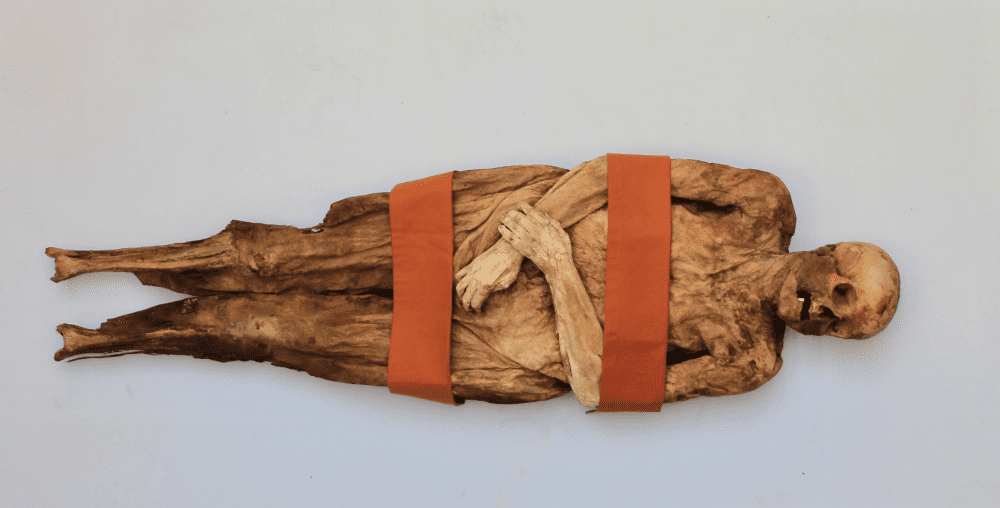A peculiar mummy was unearthed in 1975 during the renovation of the Barfüsser Church in Basel, Switzerland, as the remains of Anna Catharina Bischoff were found beneath the floors. She had died aged 68 way back in 1787, though exactly what caused her death has been the subject of some debate.
Part of the reason her corpse evaded putrefaction has been put down to the sheer volume of mercury it contained, something that was thought to hint at a diagnosis of syphilis that would’ve been treated with the toxic heavy metal at the time. However, new research says this might not be the case and instead points to an unknown brain pathogen as the possible cause of death.
While there were possible witness marks of a syphilis infection in the mummified remains of Bischoff, whose femurs, rib cage and skull exhibit lesions indicative of the disease, researchers doing a deep dive into the pathogen population of her body found no sign of Treponema pallidum – the bacterium that causes syphilis. Could it be that the mercury surging around her system cleared her of the disease that killed her, or was something else at play?
The researchers behind a new study into Bischoff’s cause of death found an “extraordinarily high abundance of Mycobacteriaceae” in her brain, both in the organ and the surrounding skull. They were able to retrieve a near-full genome for the pathogen that sits within the nontuberculous mycobacteria (NTM), revealing it had grown hardy against mercury compounds. Such resistance may have developed in response to it being used so readily as medicine at the time, in a similar way to the antibiotic-resistant bacteria we see today.
The presence and volume of these bacteria in the brain compared to the total lack of detectable T. pallidum led them to instead suggest an alternative hypotheses to death by syphilis, as had previously been suggested for the mummy who is – by the way – the great-great-great-great-great-great-great grandmother of ex-UK prime minister Boris Johnson.
“First, ACB suffered from syphilis and was exposed to a mercury treatment successfully, and T. pallidum was completely eradicated, while the NTM brain infection occurred later,” explained the study authors. “Second, she suffered from an NTM, and probably showed symptoms similar to syphilis, and was therefore subjected to mercury treatment, but the pathogen survived the mercury due to its content of mercury and heavy metal resistance genes.”
The lesions of the skull and other bones might suggest the first hypothesis, though at a molecular level it seems unlikely, they say. On the other hand, that an unidentified NTM might’ve been to blame fits the bill both molecularly and radiologically.
The NTM they detected appears to have been a nasty bug, armed to the teeth with “virulence genes and toxins” that would’ve made for a very bad time for the infected. The symptom set could well have mirrored that of syphilis, explaining why Bischoff was loaded up with mercury, but resistance to the heavy metal toxin meant this would’ve killed the patient before it kicked the pathogen.
The case is far from closed, but it’s at least cracked further open, since syphilis without evidence of its pathogen would seem like an unlikely cause of death. As for the NTM, that may mean that we should be eyeing this pathogen with more suspicion, considering it’s usually something that’s thought to exist more in the environment and not as an invader in our bodies.
“This study spots the light on one NTM as […the] cause of neglected diseases and infections, which might have been misdiagnosed as syphilis or tuberculosis during the eighteenth century and may still be overlooked or misinterpreted nowadays in paleopathological studies due to the guided interest in more common and better-known diseases,” concluded the authors.
“The study of this mummy exemplifies the importance of employing differential diagnostic approaches in paleopathological analysis by combining classical anthropological and radiological observations with molecular investigations.”
The study was published in BMC Biology.
[H/T: Haaretz]
Source Link: Boris Johnson's Mummified Ancestor Maybe Didn't Die Of Syphilis After All
